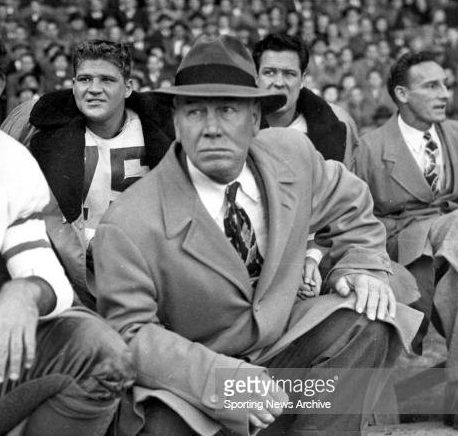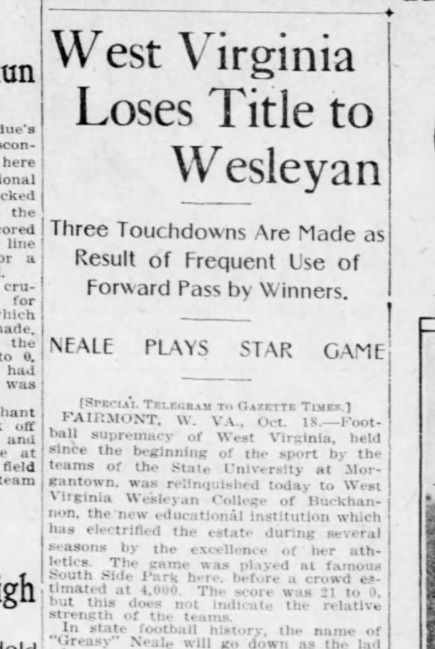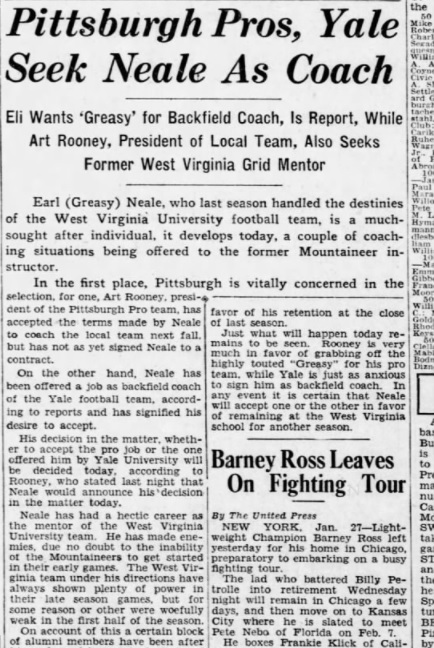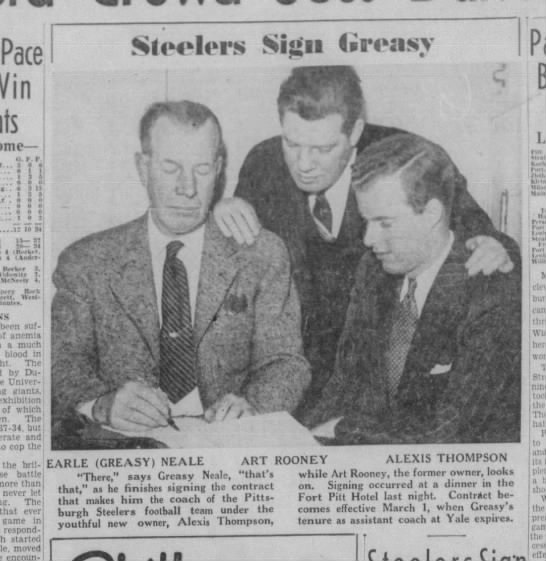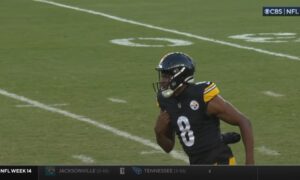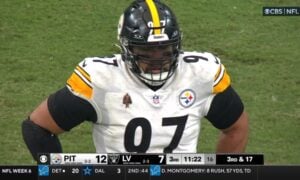DOES HE COUNT?
The Pittsburgh Steelers media guide mentions Greasy Neale as a footnote on its list of All-Time Steelers Head Coaches. The footnote states that “(Walt) Kiesling was co-head coach with Greasy Neale in 1943 (Phil-Pitt). What the media guide does not mention is that Art Rooney sold the Pittsburgh Steelers to Alexis Thompson in 1941. Thompson hired Greasy Neale to be his head coach and renamed the team the Ironmen. But within months, Bert Bell, and Art Rooney as co-owners of the Philadelphia Eagles swapped cities with Thompson.
Coach Greasy Neale and his players transformed from Pittsburgh Ironmen to Philadelphia Eagles on April 3, 1941, just days after April Fools Day. Greasy Neale counts as a former Steelers head coach from my perspective as an average Steelers fan.
EARLY LIFE
Alfred Earl “Greasy” Neale was born on November 5, 1891, in Parkersburg, WV. His father was a wholesale produce merchant and wife a homemaker. Among his five siblings, his youngest brother William “Widdy” Neale would factor in Greasy’s coaching career.
Neale used his middle name Earle or nickname Greasy in his early days and baseball career. The story goes that he was playing with a friend when a woman passing by asked how old they were. Neale’s buddy replied that they were ten, and the woman retorted, “it took you just ten years to get that dirty?” Neale began taunted his friend calling him dirty. His bud retaliated with, “if I’m ‘Dirty’ then you’re ‘Greasy!’” The moniker stuck.
The first mention I find of ‘Greasy’ Neale is in a February 7, 1912, Fairmont West Virginian article synopsizing a game between Fairmont and Parkersburg High Schools played at the local YMCA with 300 spectators packing the stands. The author noted that the Parkersburg team was “larger and a great deal taller than the local lads.” Not surprising because Neale was 21 years old when playing this high school game. I’m not sure if both teams had older players. But the article continued that “the feature of the game was the playing of ‘Greasy’ Neale … who tossed the balls towards and into the baskets with one hand ….”
COLLEGE BOUND
From Parkersburg, Neale entered West Virginia Wesleyan at Buckhannon, WV in the fall of 1912. He played football there and quickly established himself as a star player. His teammates elected Greasy captain of the team after the 1913 season and reelected him in 1914. A game that defined Neale’s approach to football occurred in October 1913 when Wesleyan defeated West Virginia University 21-0 to claim the unofficial college football championship of West Virginia. A Pittsburgh Post-Gazette article stated, “In State football history, the name of “Greasy” Neale will go down as the lad who won the championship for Wesleyan. … Neale score two of the three Wesleyan touchdowns and kicked all three of the goals.”
The article noted that all three scores were made on forward passes. West Virginia University described as the varsity with bigger players dominated when the teams played “straight” football.” The piledriving running plays that dominated football in the early years. But WVU’s defense was “hopeless when it came to breaking up the passes and stopping Neale.” An early lesson for Neale. A smaller weaker team could beat a bigger stronger group of men by passing the ball over their heads rather than trying to ram the ball through a wall of defenders.
PRO FOOTBALL AND BASEBALL PLAYER
Neale played minor league baseball beginning in the Canadian league at London, Ontario in 1912. The Cleveland Indians initially signed him while still in school, but minor league baseball did not interfere with his college athletic eligibility. The Cincinnati Redlegs signed Neale in November 1915 after he hit .351 in 51 games for Wheeling to lead the Central League in batting. Neale played 768 games in eight seasons in the national league. The Reds traded Neale to the Phillies following the 1920 season playing 22 games in Philadelphia. The Reds reclaimed Neale off waivers to finish the 1921 season in Cincinnati. His career batting average was only .259 with just eight home runs but this was the dead ball era.
The highlight of his baseball career was eight appearances in the infamous 1919 World Series versus the Chicago White (Black) Sox. He broke out of an end of season batting slump to hit .357 on ten hits and four RBIs in the World Series. As the starting right fielder, he helped the Reds win the World Series five games to three over the heavily favored Black Sox. He played four more season, but his professional baseball career was over after the 1924 season.
HE CAN PLAY FOOTBALL, TOO
Greasy Neale also played professional football three seasons just before the formation of the National Football League in 1920. In 1917, Greasy Neale played for the Canton Bulldogs coached by Jim Thorpe. Neale may have played under the alias Foster according to a Professional Football Researchers Association article about Canton’s 1917 season. He scored a winning touchdown on a Thanksgiving game against the Detroit Heralds. Canton won the Ohio League championship based on point differential in the split games with Massillon Tigers. In 1918, Greasy coached the Dayton Triangles to an undefeated championship. The War and the Spanish Flu pandemic had several teams idle in 1918 and the start of the season delayed until October and an eight-game season. In addition to Neale’s coaching, he was a leading scorer. Neale reportededly played for the Massillon Tigers in 1919 but I was unable to confirm.
A World Series champion and two-time football champion in the Ohio League, the direct predecessor of the NFL, is a rather good playing career. Adding the coaching role he did for the Dayton Triangles for their championship ices the cake.
COLLEGE COACH
Neale married Genevieve Horner April 19, 1915, while still enrolled at Wesleyan. His marriage may have hastened him to bolster earnings from playing in the minors with a coaching job. As discussed above, he played professional baseball and football. Baseball paid him thousands of dollars. He received a $5000 share for winning the 1919 World Series. That’s $78 thousand in today’s dollars. Football paid hundreds of dollars. The Ohio League teams likely paid Greasy no more than $100 per game.
A short college-school news blurb in the March 23, 1915, Pittsburgh Post-Gazette sports page announced, “Greasy Neale the star of the West Virginia Wesleyan team, will handle the football team at Muskingum.” Just weeks prior, West Virginia Wesleyan basketball box scores listed Neale as a guard. At the end of baseball season with minor league Wheeling, Greasy showed up at his new post as athletic director of Muskingum on September 15, 1915. Muskingum finished the season 2-4-1 but optimism prevailed. The team was noted to be “well versed in forward passing.” A touchdown against then national power Washington & Jefferson boosted the team’s confidence.
Greasy kept very busy. During his rookie season with the Cincinnati Reds, a June 16, 1916, Pittsburgh Post-Gazette article stated that “Greasy Neale … signed a contract to coach the West Virginia Wesleyan football team in the fall.” A box score on the same page showed that Neale had two hits in four at bats in a 3-1 losing effort to the Cardinals. In a twist, Muskingum released Neale from his contract in August and signed his former coach at West Virginia Wesleyan J.L. Felton. The two teams were to meet in the season opener with Neale leading his alma mater to an easy 40-0 win. Washington & Jefferson put West Virginia Wesleyan into their place with a 21-0 win. Wesleyan finished a tough schedule with a humbling 54-7 loss to West Virginia University for the unofficial state championship.
PLAY SUSPENDED, SWITCHES SCHOOLS
In 1917, Wesleyan went 5-2 with close losses to Washington & Jefferson (13-6) and Penn State (8-7). Wesleyan avenged the big loss to West Virginia the previous season with a 20-0 win in 1917. Just their third in 12 games played since 1902. 1918 promised to be a strong year for Wesleyan which had many freshmen playing the previous season. However, the Great War and Spanish Flu pandemic caused many schools to truncate or end their seasons altogether. Wesleyan cancelled their season and converted their football field to a drill ground for the student Army Training Corps. Neale played fullback and coached the Dayton Triangles leading the team to a 9-0 record. The pandemic had several big teams like Canton and Massillon suspending play for the season.
Neale jumped to Massillon to play in 1919 but coached at Marietta College in 1919-20. Neale coached younger brother “Dutch” Neale on the Marietta team. Although nationally known as a starting outfielder with the 1919 world champion Cincinnati Reds, Neale made his preferences known in an interview: “Baseball is my profession because that is where I get my living, but if the choice were left to me, I’d say football every time. I’d rather coach a football team than play baseball. … The old fight and spirit make the game and keep a fellow in love with it forever.”
BASEBALL MARIETTA DANCE
The Marietta College football reference says Marietta had a 14-1 record over Neale’s two seasons as head coach. But finding a full schedule is difficult. I did find a score with West Virginia pounding tiny Marietta 61-0 on September 27 while Neale played for the Reds and before he became football and basketball coach at Marietta. One sports article noted that “’Greasy’ Neale star outfielder of the Cincinnati Reds has been offered the job of football coach at Marietta College.”
The Reds would claim the World Series by winning the eight games on October 9. Somehow he made time to transform the Marietta football team within weeks by recruiting ringers including his brother Dutch who had played for Wesleyan before entering military service. His Marietta team won the remainder of their schedule and was unscored upon including beating West Virginia Wesleyan 27-0.
Marietta went undefeated until facing Boston College at Fenway Park. Marietta took an early lead but lost 13-3. Yale was the only other team to score on Boston College who were undefeated in 1920.
In the meantime, the Reds traded Neale to the Philadelphia Phillies in the offseason.
ROSE BOWL BOUND
Washington & Jefferson (W&J) College signed Neale to a contract just before baseball season. Neale negotiated an agreement to curtail his baseball season so that he could report to Washington & Jefferson on September 1 regardless of the standings. He was the fourteenth football coach at the school since 1890. He led the school to an undefeated season and an appearance in the Rose Bowl.
W&J was 7-0 but had three tough road games to finish the season:
Playing Pitt on November 12 was a key game. The Presidents had lost six straight to Pitt since winning a game in 1914.
FINISHING STRONG
Pitt had an off year finishing 5-3-1 but was still a powerful opponent. Playing in “ankle-deep mud,” the two teams were scoreless until the fourth quarter. W&J reached the eight-yard line, but the Pitt defense tackled Erickson for a 12-yard loss. Most of the day the teams slogged through the muck on running plays. The teams combined for just six first downs in the entire game. On the next play, Brenkert passed to a wide-open Herb Kopf at the ten-yard line who scored on the 20-yard passing play. W&J now 8-0 still had to play West Virginia University for bragging rights in the Mountain State and the University of Detroit.
W&J scored early on a 50-yard run by Erickson to take a first quarter lead on West Virginia. Then the Presidents clamped down on defense and won an easy 13-0 win over the Mountaineers. W&J took a train to Detroit to play their final opponent in the regular season. Detroit shutout seven of eight opponents before facing the Presidents. Only Tulane scored in a 14-10 game. W&J had to win this game else the Carnival of Roses organization might withdraw its invitation for the Presidents to play in the Rose Bowl. W&J scored in the first quarter after blocking a punt and Batista plunged over from the one to make it 7-0.
Detroit’s tough defense scored a safety but then in the second quarter Greasy Neale unleashed some razzle dazzle. Erickson received the ball after a double pass then ran 64 yards breaking four tackles to score the final points of the game. 14-2.
WESTWARD BOUND
Charles West started the game at quarterback for the regular starter McLaughlin. West played halfback most of the season but subbed for McLaughlin at quarterback in the Detroit game. Both were on the list of players to travel to California. I could not find out why McLaughlin did not play. Perhaps, Neale wanted a more mobile backfield with West at quarterback and Erickson and stopped in Kansas City to practice day after Christmas. 20 players. West would go on to become the first African-American to play quarterback in the Rose Bowl.
Cal was favored by 2-3 touchdowns in the Rose Bowl and had beat Ohio State 28-0 the previous year. Tiny W&J with an enrollment of only 450 students was the clear underdog. W&J travelled to California by train with just 20 players. One got sick on the way and could not play.
Greasy played just eleven players making no substitutions which was a first. Brenkert scored from 40 yards early in the game, however, officials flagged Russell Stein for offsides on the play disallowing the score. W&J outgained California in the defensive struggle with eight first downs to just two for California. But the negated W&J score was the only time either team crossed the goal line. A crazy game that included 29 total punts between the two teams.
CAN’T REPEAT THE MAGIC
Washington & Jefferson could not repeat the magic in 1922. The team started out 6-0-1 including a thrilling 14-13 victory over Jock Sutherland’s Lafayette team. but finished the season with three straight losses to Pitt, Detroit Mercy, and West Virginia. Neale’s announced intention of moving on from W&J marred the season. Neale was heard saying, “I don’t like Washington and there are a lot of people in Washington that don’t like me.” The school’s athletic committee wanted to keep Neale but also follow their direction such as hiring another assistant line coach. Greasy was frying mad. During the losing streak, the W&J athletic committee offered the Athletic Directorship to no less than Knute Rockne who reportedly accepted the offer in principle if Notre Dame released him from his contract. At the same time, the committee expressed a desire to retain Neale. Washington & Jefferson would end up with neither. The Presidents new coach would be John Heisman. Yes, that John Heisman albeit for just one season.
Some W&J Folklore
Former President of Washington & Jefferson College, Tori Haring-Smith related this bit of folklore during my son Nick’s matriculation ceremony there. After the Rose Bowl season, Washington & Lee was scheduled to travel to play W&J in football. At that time, Washington & Lee was a segregated school. In those days, the home team would split the gate with the visiting team. Under the contract if the game was not played the visiting team was due compensation.
Upon arrival, the Washington & Lee team advised they would not take field if Charles West played in the game. The W&J coach told Washington and Lee they were not playing the game without West on the field. The game was not played and W&J had to forfeit the monies due Washington and Lee under the contract. The kicker was that West was injured and not available to play in the game, but the team stood by their principles. I was not able to confirm these events via contemporary newspaper articles but it is a good story.
NEALE TAKES A BREAK FROM COLLEGE COACHING
As for Greasy, the University of Virginia signed him to a one-year deal to coach the football and baseball teams. He stepped away from baseball in 1923 although he would come back for three games in 1924. That one-year contract at Virginia resulted in six seasons in Charlottesville. The Cavaliers would go 28-22-5 coached by Neale with the 7-1-1 1925 team the best season. He stepped away from coaching college football for baseball to spend 1929 on the Saint Louis Cardinals coaching staff.
A management change left Neale out of baseball and no coaching job. He coached semipro football teams in 1929 and 1930. He may have caught the notice by playing three NFL teams in five games. His Ironton Tank team defeated the Chicago Bears 26-13, New York Giants 13-12 and going 1-2 versus the Portsmouth Spartans (today’s Detroit Lions).
GREASY SLIPS AWAY FROM PITTSBURGH
Greasy finished out his collegiate head coaching career at West Virginia from 1931-1933. When Neale resigned from West Virginia he had options. Art Rooney offered him a head coaching job in professional football for the 1934 season. But Neale also had an offer to be the backfield coach at Yale.
Greasy had another brother Widdy who graduated Yale 1925 three sport star. The new head coach, Raymond “Ducky” Pond, hired Greasy as backs coach. Neale chose to join his brother who was employed at Yale. College football was more prestigious than the pro game in those days and he had a familial bond. Greasy stayed as Yale’s backfield coach from 1934-1940. At one point, Yale tried unsuccessfully for Neale to drop his nickname. Apparently, Yale considered “Ducky” and acceptable moniker but not “Greasy.”
As a college coach, Greasy Neale favored the open passing game helping his underdog smaller teams to punch above their weight against heavier bigger opponents.
SAME OLD EAGLES
Greasy Neale kept his moniker and position as assistant coach at Yale through the 1940 season. But in December 1940, Neale signed a contract with an NFL team. No. Not the Philadelphia Eagles but the Pittsburgh Steelers!
Art Rooney sold the Pittsburgh Steelers to 26-year-old Alexis Thompson for $150-165 thousand. Thompson signed Neale to a contract that would take effect on March 1, 1941, as soon as his term at Yale expired. The question was whether Thompson would keep the Steelers in Pittsburgh or move the team to Boston to replace the Redskins that had vacated Beantown for Washington DC in 1937.
In a whirlwind, the two ownership groups divided the Eagles and Steelers rosters. Greasy as new Steelers coach retained young Tommy Thompson who the Steelers signed as an undrafted free agent before the 1940 season. Walt Kiesling as Eagles coach focused on building a strong line. The back had a good arm. But in a surprise move, Thompson and the Bell-Rooney swapped cities. So, Steelers coach Greasy Neale and Tommy Thompson became Philadelphia Eagles just a few months later. You can read more about the 1941 Iron Men here.
Instead of becoming Pittsburgh’s first true quarterback, Tommy Thompson would win two NFL championships and beat the Steelers in their very first playoff appearance as a Philadelphia Eagle. Greasy Neale had an eye for talent and believed in the passing game.
Still the Eagles won just four games and tied one in their first two years with Neale at the helm. Two of those wins and the tie came at the expense of the Pittsburgh Steelers. However, Thompson was their passing leader and made the 1942 pro bowl team.
STEAGLES
The NFL hemorrhaged players as many joined or were drafted into the military or worked in critical industries supporting the war effort. Tommie Thompson who began his NFL career as a Steeler became a star in Neale’s passing T Formation. In March 1943 Thompson enlisted in the army who accepted him for limited duty despite only having full sight in one eye.
The NFL draft held April 8 in Chicago with both the Eagles and Steelers selecting sixty college players as separate teams. Most would be unavailable immediately due to the needs of the armed services. There was also a lottery to divide the available Cleveland Rams players and draftees among the eight squads that would compete in 1943. The least number of teams with 1932 to compete in a season.
A Pittsburgh Press article reported that Greasy Neale held a press conference with Steelers president Bert Bell and Eagles general manager Harry Thayer on June 26. This was the first meeting of the combined management team of the soon to be nicknamed Steagles. Kiesling who was to co-coach introduced as Neale’s number one assistant.
THE DEAL
In May, Art Rooney stated they were down to five players and discussed the situation with Bert Bell. In June the owners approved the merger on a 6-3 vote.
- Pool expenses split profits
- Neale and Kiesling co-coaches
- Team called Eagles
- Home games both Pittsburgh (2) and Philadelphia (4)
- Teams would retain original rights to players who played for merged teams.
NFL approved, with one vote in league meeting to Philadelphia. Bears-Cardinal’s merger proposal withdrawn; Cleveland Rams suspended operations.
Neale took lead to install the T Formation offense. Walt Kiesling took charge of the linemen. Tommy Thompson’s absence led Neale to start Roy Zimmerman as his passing quarterback. Ironically, the Steagles led the NFL is rushing offense in 1943 not passing. Zimmerman threw 17 of the teams 20 interceptions that year.
A WINNING COMBINATION
The Steagles started strong shutting out Brooklyn Dodgers 17-0 and then beating the New York Giants 28-14 despite fumbling ten times. Zimmerman threw two touchdown passes but also an early pick-six against the Giants. The Steagles took an early 7-0 lead against the might Chicago Bears on a 61-yard Zimmerman touchdown pass. But then the Bears clamped down winning 48-21. The Giants gained revenge blocking tow punts for touchdowns and winning the rematch 42-14 to even the Steagles record at 2-2.
In the first of two home games played in Pittsburgh, the Steagles beat the Chicago Cardinals 34-13 with Zimmerman throwing two more touchdown passes. The defense added a pick-six and a fumble recovery in the endzone. Only 16,351 fans attended. Next week they hosted another home game but now in Philadelphia’s Shibe park. In front of 28,893 fans, the Steagles tied the Washington Redskins 14-14. The Redskins eventually played Chicago in the championship. A Zimmerman touchdown pass late in the game tied the game. Brooklyn upset the Steagles 13-7 to even their record at 3-3-1.
Back in Pittsburgh, the Steagles edged the Detroit Lions 35-34 in an exciting game with 23,338 fans watching at Forbes Field. The Steagles then traveled to Washington to take on the 6-0-1 Redskins. They handed Washington their first loss 27-14. The Steagles still had a chance of winning the division if they won their next game and Washington dropped the next two. It might force a playoff with the New York Giants who played the Redskins in the final two games.
CLOSE BUT NO CIGAR
The Redskins did lose their next two games against the Giants. The Tony Bova caught three passes for 106 yards and two touchdowns against the Green Bay Packers. But it was not enough. The Steagles threw six interceptions and lost two fumbles losing 38-28 and a third-place finish in the division.
The Steagles had a winning season, but the merged teams separated after the season with both Philadelphia and Pittsburgh preferring to go their separate ways. 19 of the 25 players who finished the season belonged to the Eagles, so Pittsburgh would have to recruit hard to be a viable team in 1944.
EAGLES SOAR
Greasy Neale coached the Eagles for seven more seasons from 1944 to 1950. Neale got the Eagles soaring first by drafting five-time first team all pro and Hall of Fame running back Steve Van Buren in 1944. Then drafting Pete Pihos, a Hall of Fame receiver who was also five-time first team All-Pro. Roy Zimmerman was his leading passer for two more seasons after the Steagles. Then Tommy Thompson returned to the Eagles as the starting quarterback on the championship teams plus the 1947 playoff defeat of the Steelers when the Eagles were runners up in league championship. The Eagles had six straight winning seasons including two world championships.
The Eagles fired Neale after the 1950 season when they went 6-6. Alexis Thompson who had brought the Eagles to Philadelphia from Pittsburgh and first hired Neale sold the team in January 1949 after they won their first championship. Neale had a fractious relationship with the new management team. After receiving the news of his removal with one year remaining on his contract Neale mused, “I guess you have to have a championship every year to satisfy them. Last year we lost five games by eighteen points. For two straight years before that we won the National League title … I guess I’ll just sit back and collect on it.”
AFTERMATH
Greasy Neale’s fabulous coaching career ended in 1950. The Eagles would not win another championship until 1960. He was inducted into the College Football Hall of Fame in 1967 and the Pro Football Hall of Fame in 1969. Tack on that baseball World Series championship and you have quite a career. I just wonder what he would have accomplished if Art Rooney managed to lure him away from Yale back in 1934.
Greasy Neale spent his years after coaching in Florida by golfing and watching football games. He died in 1973 at the age of 81.
PRIOR STEELERS COACHES
Here is a list of coaches prior to John Michelosen’s tenure with links to Steelers Depot articles about them:
| Forrest Douds
1933 |
Luby DiMeolo
1934 |
Joe Bach
1935-36 1952-53 |
John McNally
1937-39 |
Walt Kiesling
1939-44 1954-56 |
| Bert Bell
1941 |
Aldo Donelli
1941 |
Greasy Neale*
1943 |
Phil Handler**
1944 |
Jim Leonard
1945 |
| Jock Sutherland
1946-47 |
John Michelosen
1948-51 |
|||
*Co-coach of 1943 Steagles **Co-coach of 1944 Car-Pits
YOUR SONG SELECTION
I always like to include a song. Greasy Neale was always slipping away. The nearer your destination the more you’re slip sliding away. Here is Slip Slidin’ Away by Paul Simon.

